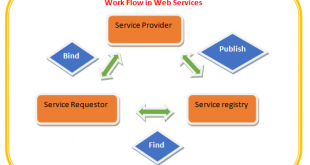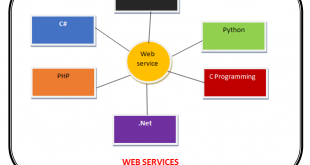Characteristics of Web services:
Loosely coupled:
A web service consumer is not directly tied with web service. The web service interface can change over the period of time without clients intimation or compromising the clients ability to interact with the service. A tightly coupled system implies that the client and server logic are closely tied to one another, implying that if one interface changes, the other must be changed. By loosely coupled approach the above problem is overcome so web services are loosely coupled.
XML based:
Web services are used XML to describe, messaging data from one to another and data transportation layer. XML eliminates any networking, operating system, or platform binding and Web Services based applications are profoundly inter-operable application at their center level.
Minimal Effort of Communication:
Web administrations utilize SOAP over HTTP convention, so you can utilize your current ease web for actualizing web administrations. This will reduce the cost and less expensive contrasted with exclusive arrangements like EDI/B2B. Other than SOAP over HTTP, web administrations can likewise be executed on other solid transport instruments like FTP.
Coarse-Grained:
[Coarse-grained: A few objects hold a lot of related data that’s why services have broader scope in functionality. Example: A single “Account” object holds the customer name, address, account balance, opening date, last change date, etc. Thus: Increased design complexity, smaller number of cells to various operations. larger components than fine-grained, large sub components. Simply wraps one or more fine-grained services together into a more coarse-grained operation.Fine-grained: More objects each holding less data that’s why services have more narrow scope in functionality. Example: An Account object holds balance, a Customer object holds name and address, a Account Openings object holds opening date, etc. Thus: Decreased design complexity ,higher number of cells to various service operations. These are relationships defined between these objects. smaller components of which the larger ones are composed, lower level service It is better to have more coarse-grained service operations, which are composed by fine-grained operations ]
Object-oriented technologies such as Java expose their services through individual methods. An individual method is too fine an operation to provide any useful capability at a corporate level. Building a Java program from scratch requires the creation of several fine-grained methods that are then composed into a coarse-grained service that is consumed by either a client or another service. Businesses and the interfaces that they expose should be coarse-grained. Web services technology provides a natural way of defining coarse-grained services that access the right amount of business logic.
Interoperability :
This is the main characteristic of web service. Webservices helps to communicate one application to another application and both are implemented in different platform this is known as interoperability. Web administrations enable different applications to converse with each other and offer information and administrations among themselves. Different applications can likewise utilize the web administrations. For instance, a VB or .NET application can converse with Java web administrations and the other way around. Web administrations are utilized to make the application stage and innovation autonomous.
Institutionalized Protocol
Web administrations utilize institutionalized industry standard convention for the correspondence. All the four layers (Service Transport, XML Messaging, Service Description, and Service Discovery layers) utilize very much characterized conventions in the web administrations convention stack. This institutionalization of convention stack gives the business many focal points, for example, an extensive variety of decisions, lessening in the cost because of rivalry, and increment in the quality.
Capability to be Synchronous or Asynchronous
Synchronicity alludes to the official of the customer to the execution of the administration. In synchronous summons, the customer pieces and sits tight for the support of finish its operation before proceeding. Non concurrent operations enable a customer to summon an administration and after that execute different capacities.
Non concurrent customers recover their outcome at a later point in time, while synchronous customers get their outcome when the administration has finished. Offbeat capacity is a key factor in empowering inexactly coupled frameworks.
Synchronicity refers to the binding of the client to the execution of the service. In synchronous invocations, the client blocks and waits for the service to complete its operation before continuing. Asynchronous operations allow a client to invoke a service and then execute other functions.
Asynchronous clients retrieve their result at a later point in time, while synchronous clients receive their result when the service has completed. Asynchronous capability is a key factor in enabling loosely coupled systems.
Supports Document Exchange:
One of the key advantages of XML is its generic way of representing not only data, but also complex documents. These documents can be as simple as representing a current address, or they can be as complex as representing an entire book or Request for Quotation (RFQ). Web services support the transparent exchange of documents to facilitate business integration.
Supports Remote Procedure Calls:
( Remote Procedure call: In distributed computing, a remote procedure call (RPC) is when a computer program causes a procedure (subroutine) to execute in a different address space (commonly on another computer on a shared network), which is coded as if it was a normal (local) procedure call, without the programmer explicitly coding the details for the remote interaction.)
Web services allow clients to invoke procedures, functions, and methods on remote objects using an XML-based protocol. Remote procedures expose input and output parameters that a web service must support.
A web service supports RPC by providing services of its own, equivalent to those of a traditional component, or by translating incoming invocations into an invocation of an EJB or a .NET component.
Segment advancement through Enterprise JavaBeans (EJBs) and .NET Components has progressively turned into a piece of structures and endeavor organizations over the recent years. The two advancements are circulated and open through an assortment of RPC components.
 IT2EDU Empowering Education Through Technology
IT2EDU Empowering Education Through Technology


